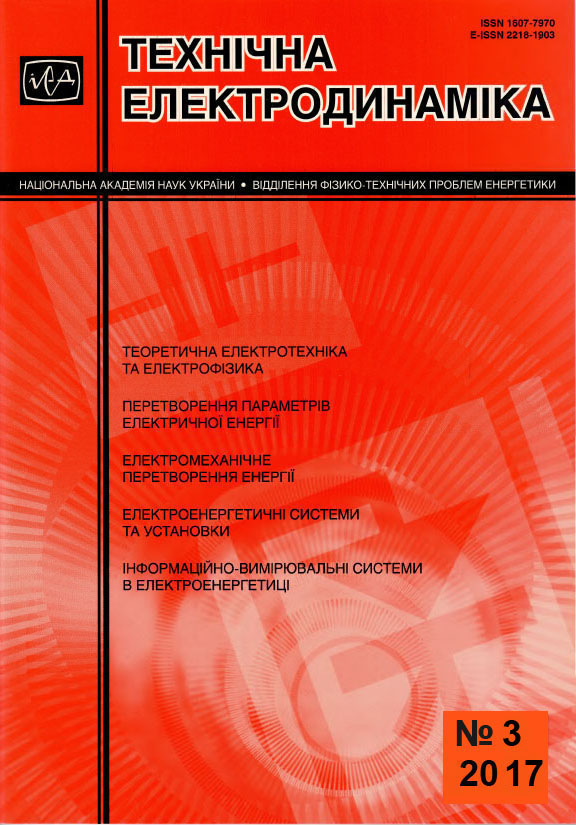Анотація
Разработана трехмерная математическая модель и выполнен анализ неоднородного распределения магнитного и температурного полей в футерованном индукторе плавильно-раздаточной печи для плавки меди и в медном шаблоне. Анализ проводился с учетом сложной геометрии индуктора (характерные размеры элементов которого существенно отличаются), нелинейной зависимости удельной электропроводности меди от температуры, ферромагнитных свойств стального сердечника магнитопровода и наличия водного охлаждения медных шин индуктора и его корпуса, а также температуры и массопереноса жидкости. Рассмотрен долговременный процесс плавления медного шаблона длительностью 18 часов при нестационарном питании индуктора. Определены локальные области наибольших температур и градиентов температуры в футеровке индуктора и их изменение во времени для анализа надежности и ресурса плавильно-раздаточной печи. Библ. 18, рис. 7.
Посилання
Zolotarev V.M., Belyanin R.V., Podoltsev О.D. Analysis of electromagnetic processes in the induction channel furnace used in the cable industry // Pratsi Instytutu Elektrodynamiky Natsionalnoi Akademii Nauk Ukrainy. – 2016. – Vol. 44. – Pp. 110–115. (Rus)
Shcherba A.A., Podoltsev О.D., Kucheriava I.М., Ushakov V.I. Computer modeling of electrothermal processes and thermomechanical stress at induction heating of moving copper ingots // Tekhnichna Elektrodynamika. – 2013. – No 2. – Pp. 10–18. (Rus)
Shcherba М.А. Patterns of the electric field distribution in a dielectric medium at changing of sizes and shapes of the conducting inclusions // Tekhnichna Elektrodynamika. – 2012. – Vol. 2. – Pp. 19–20. (Rus)
Shcherba M.A. The features of the local electric field amplifications by conducting inclusions in nonlinear polymer insulation // Tekhnichna Elektrodynamika. – 2015. – Vol. 2. – Pp. 16–23. (Rus)
Shcherba M.А., Podoltsev A.D. Electric field and current density distribution near water inclusions of polymer insulation of high-voltage cables in view of its nonlinear properties // Tekhnichna Elektrodynamika. – 2016. – Vol. 1. – Pp. 11–19. (Rus) DOI: https://doi.org/10.15407/techned2016.01.011
Baake E., Nacke B., Bernier F., Vogt M. Experimental and numerical investigations of the temperature field and melt flow in the induction furnace with cold crucible // Intern. J. for computation and mathematics in electrical and electronic engineering COMPEL. – 2003. – Vol. 22(1). – Pp. 88–97.
Bay F., Labbé V., Favennec Y. A numerical model for induction heating processes coupling electro-magnetism and thermomechanics // Intern. J. for Numerical Methods in Engineering. – 2003. – Vol. 58(6). – Pp. 839–867.
Bermúdez A., Gómez D., Muñiz M.C., Salgado P., Vázquez R. Numerical simulation of a thermo-electromagnetohydrodynamic problem in an induction heating furnace // Applied Numerical Mathematics. – 2009. –Vol. 59(9). – Pp. 2082–2104.
Bermúdez A., Gómez D., Muñiz M.C., Salgado P. Transient numerical simulation of a thermoelectrical problem in cylindrical induction heating furnaces // Advances in computational mathematics. – 2007. – Vol. 26(1-3). – Pp. 39–62.
Chaboudez C., Clain S., Glardon R., Mari D. Numerical modeling in induction heating for axisymmetric geometries // IEEE Trans. on Magnetics. – 1997. – Vol. 33(1). – Рр. 739–745.
Comsol Multiphysics, https://www.comsol.com/, Comsol Inc., Burlington, MA, USA, 2017.
Ghojel J.I., Ibrahim R.N. Computer simulation of the thermal regime of double-loop channel induction furnaces // J. of materials processing technology. – 2004. – Vol. 153. – Рр. 386–391.
Lucía O., Maussion P., Dede E.J. Induction heating technology and its applications: past developments, current technology, and future challenges // IEEE Trans. on Industrial Electronics. – 2014. – Vol. 61.5. – Pp. 2509–2520.
Rapoport E., Pleshivtseva Yu. Optimal control of induction heating processes. – CRC Press, 2006.
Rudnev V., Loveless D., Cook R.L., Black M. Handbook of induction heating. – CRC Press, 2002.
Ter Maten E.J.W., Melissen J.B.M. Simulation of inductive heating // IEEE Trans. on Magnetics. – 1992. – Vol. 28.2. – Pp. 1287–1290.
Umbrashko A., Baake E., Nacke B., Jakovics A. Modeling of the turbulent flow in induction furnaces // Metallurgical and Materials Trans. – 2006. – Vol. 37(5). – Pp. 831–838.
UPCAST, http://www.upcast.com/, Finland.

Ця робота ліцензується відповідно до Creative Commons Attribution-NonCommercial-NoDerivatives 4.0 International License.
Авторське право (c) 2022 ТЕХНІЧНА ЕЛЕКТРОДИНАМІКА

